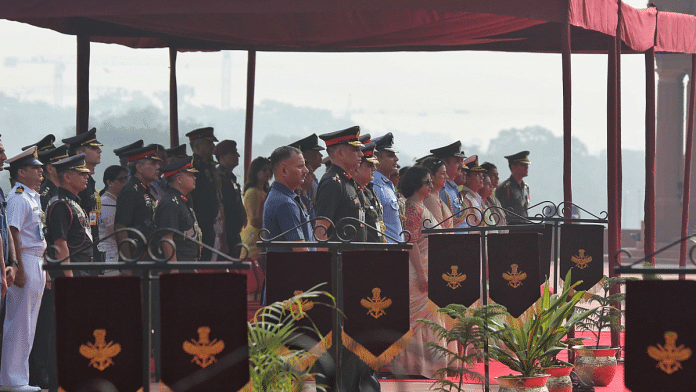After observing hostilities for more than a year, it took an annual dialogue for India’s top military brass to elaborately comment on the Russia-Ukraine conflict. Much like the Narendra Modi government, the Indian military brass has been chary of speaking on the conflict that has shaken economies, changed perceptions about war-fighting around the world, and even altered global air travel. An Indian military assessment was a long time coming. It arrived in rather plush environs — at the 8th Raisina Dialogue, jointly organised by the Ministry of External Affairs and Observer Research Foundation, in Delhi on 2 March. The session was attended by former United States Marine Corps chief Gen James Mattis and Australia’s Chief of Defence Force Gen Angus Campbell.
Supported by a session titled ‘The Old, The New, and The Unconventional: Assessing Contemporary Conflicts’, Chief of Defence Staff (CDS) Gen Anil Chauhan opened up when others have been reticent to express anything publicly.
An Indian assessment of the Russia-Ukraine war was long overdue for various reasons. One, much like the India-China conflict, the war involves neighbours of grossly unequal size, relative power, and economies. External Affairs Minister S Jaishankar’s now-missing comment from his exclusive interview with Asian News International (ANI) saying that India couldn’t fight China owing to its economic imbalance flies in the face of resistance displayed by Ukraine. Jaishankar’s statement was severely criticised by military veterans since the likelihood of being placed in a situation similar to Ukraine’s always remains in operational planning.
Also read: India must detach from Russia. Exports, IT, or education, its interests lie with the…
Did Indian military get it right?
The CDS made an important point about the types of weapons required in modern conflicts such as in Ukraine. While high-precision weapons are essential for short wars, conventional systems, especially artillery and armour munitions, are required in longer conflicts. The interesting aspect of the war in Ukraine is that both types of weapons and munitions are expressly required. While high-precision systems steal the limelight, the need for conventional munitions has also been felt, requiring superior logistics. On the latter count, Russia was caught napping earlier. The current situation, though, is far from clear.
Truth is always the first casualty of war, and this adage is particularly apt for the Russia-Ukraine conflict. With the Western world ranged against Moscow, and information operations in full gear, Russia has been on the losing side of the conflict since the first week. This success is largely due to the excellent diplomatic relations of Ukraine President Volodymyr Zelenskyy with world leaders. Winning the “cognitive war” can be just as important as military might is a lesson deeply understood by Chinese military authorities — Beijing and the People’s Liberation Army (PLA) may face more challenges than missiles and tanks in any military action against Taiwan.
Gen Chauhan also said that there are no universal lessons to be drawn from this war since all countries will make their own assessment. Initially, it was postulated that it would be a short, swift Russian victory. Time proved them wrong. While it was assumed that dispersions and demassification had become a military norm over time, in the case of the Russia-Ukraine conflict, the opposite seems to be happening. The CDS called it the ‘return of trench warfare’. Since the frontline has barely moved, this comment has important lessons for Indian planning.
Also read: China’s position on Russia-Ukraine war could bring US sanctions into play
Lessons for India
A cursory look at the battlefield and surrounding terrain in eastern Ukraine shows a striking similarity to the agricultural plains in Punjab for which India has been making operational plans. A densely populated area, dotted with industrial zones, built-up urban spaces, and a network of irrigation canals scattered around the countryside is an appropriate description for Punjab as well as for Donbas in eastern Ukraine. So, it is little wonder that over two conventional conflicts, India and Pakistan could barely gain any territory in this theatre. And that is what is happening in Donbas as well.
India can be in a unique position if it sees through the fog of war. In a very real way, it is sustaining the war from the Russian side. Plenty of commentary around the world suggests that Russia has been able to sustain the conflict because of a surge in trade with India. Russian-sourced crude oil occupies the largest share in India’s import basket. In February 2023, New Delhi imported more than a third of its crude from Russia — a share that has grown 14 times since the conflict began.
India should leverage its unique role in Russia’s economic affairs and ask Moscow for a pole-position view of how the conflict is unfolding. From high-precision weapons to efficient logistics, and contracted soldiers aka Agniveers to fighting in built-up areas, India can take insight from Donbas on everything it would have to face in a fight on the Punjab plains. And the size coefficient would also equal the current combatants.
Manvendra Singh is a Congress leader, Editor-in-Chief of Defence & Security Alert and Chairman, Soldier Welfare Advisory Committee, Rajasthan. He tweets @ManvendraJasol. Views are personal.
(Edited by Humra Laeeq)






